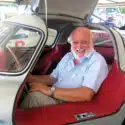Doug Nye
“The classic and historic car world is rife with self-serving deception”
The Grand Palais exhibition hall in Paris is a massive and mighty impressive structure; classical stone facades with internal cast-iron and steel columns and arches supporting a vast barrel-vaulted glass roof. It was constructed on a site between the Champs Élysées and the north bank of the Seine, not far from the Place de la Concorde, in 1900. From around 1910 until 1961 it served as home to the annual Paris Salon de l’Automobile motor show. This bugs the hell out of me since I am sure I remember attending the Salon in just such a distinctive building around 1964-65, but the show had apparently moved to the present Porte de Versailles site by then. Funny thing, memory…
Regardless, this year I was there for the Retromobile week Bonhams sale. I have been a consultant to the auction company for donkey’s years, and for this sale I had spent ages establishing detailed histories for several of the cars on offer. Competition cars, of course, because my knowledge of street cars and interest in them is effectively undetectable.
So, I’d spent a couple of days showing interested visitors around the ex-Carl Junker 1931 Australian Grand Prix-winning Bugatti Type 39, and the ex-Pietro Lo Piccolo 1970 Targa Florio Ferrari Dino 206SP – what a gem. And then there was the late, much-missed Geoffrey St John’s utterly glorious Bugatti Type 55. It had begun life as a works car in the 1931 Le Mans 24 Hours, co-driven lucklessly by Louis Chiron and Guy Bouriat, before being re-bodied uniquely by Levallois-based Italian coachbuilder Giuseppe Figoni. Leading British Bugatti exponent St John owned that car for 55 years, and happily it was briskly sold for some €4.6m.
Now, late on the viewing day, we were about to leave when that capable historic racing driver Sam Hancock button-holed me. He was fronting a Retromobile round-up video show on Snapgrab, InstaFlash or somesuch – I don’t understand these interweb things – and he asked me for a favourite sale car to talk about on camera.
I thought immediately of Lot 232, which was the ex-Lord Ebury 1931 4½-litre ‘Low-Chassis’ Invicta Type S, as built by Captain Noel Macklin’s fine company at Fairmile in Cobham, beside the A3. This remarkable survivor has – despite running and driving well – hardly been touched cosmetically since at least the end of World War II. Its faded and peeling paint and its well-worn and burst leather seats might be anathema to many fastidious collectors, but for those who prize unadorned originality and the grizzled qualities of a timeless surviving eyewitness to a bygone age – this Invicta had it all.
“The actual history of any artefact is never within the gift of mere man”
I stood there beside it – not far from the spot where a photograph I have was taken, which shows Enzo Ferrari on the Alfa Romeo stand at the 1924 Paris Salon. I tried to explain to the camera just what made this car so special for discerning – and understanding – connoisseurs. The truth is that a restoration is simultaneously an act of obliteration. As more surviving unspoiled cars are restored each year, so the world’s treasury of such fascinating, albeit tatty, gems diminish. This makes these unrestored survivors even rarer. By the simple law of supply and demand, as the former contracts, the value to the latter inflates.
Fortunately, the day after our filming, this proved to be true in the Invicta’s case. A vigorous bidding battle for it was resolved at €1.6m, which left the bright and shiny fastidious brigade shaking their heads in uncomprehending wonder.
This left me thinking about how some truths about collectability deserve repeating. One is the point demonstrated above. Then there’s the sometimes weird interface between enthusiasm, perhaps flexible honesty, and sheer greed, which surfaces so often in the old banger trade. Relating to this, I’ll repeat an observation I first made some years ago.
The classic and historic car world is rife with self-serving deception, and also with self-serving self-deception.
In truth, the actual history of any artefact is never within the gift of any, inevitably temporary, owner. There was an early Lotus sports car, sold to the US, returned later as a bent and battered relic. It was then ‘restored’ – basically by having its chassis frame replaced by new. The contemporary owner later sold the discarded original frame into other hands, while specifying that “the history does not go with this frame”. In other words, he attempted to specify that “the history” of the car and its American ownership would only be attached to the recreated car, assembled around the replacement, around one-year-old, chassis frame instead.
Such a stance is indefensible nonsense. The history of the original, discarded and now-sold chassis frame is indelible and remains so until the day that the last vestige of that structure is finally melted down or simply corrodes away. Some things are not within the gift of mere man, and this is one of them. As for chassis plates, they’re a minor consideration in the factual scheme of things.
And this is a self-evident truth which many enthusiasts, whether that enthusiasm is for interesting cars or mere transient profit, often forget under the enveloping onset of self-deception. But remember, an awful lot of evidence and an awful lot of witnesses are still around.

